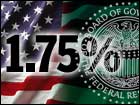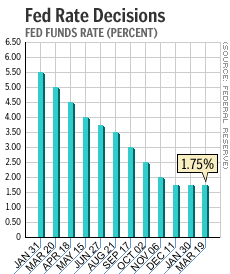
NEW YORK (CNN/Money) - After the Federal Reserve's latest decision to leave short-term interest rates alone and an avalanche of positive data about the strength of the U.S. economy, speculation has already begun about the pace at which the Fed might start to raise rates again.
Though a growing number of economists believe first-quarter economic growth will be surprisingly strong, others see a less robust recovery for the rest of the year and think the central bank will not raise rates as aggressively as the markets expect.
The Fed decided Tuesday to leave rates alone and said the risks to the economy were balanced between a risk of economic weakness and a risk of inflation. Traders in the bond market expect the Fed to start raising rates as soon as its next policy meeting, scheduled for May 7.
The implied yield on the federal funds futures contract indicates traders think the Fed will raise its target for the fed funds rate a quarter percentage point to 2.0 percent in May and that the target could go as high as 3 percent by the end of the year.

And a number of economists have recently raised their estimates for first-quarter growth in gross domestic product (GDP), the broadest measure of economic strength. Many economists now expect growth of 4 percent or more in the first quarter, which would be the strongest performance since the second quarter of 2000, when GDP grew 5.7 percent.
The Fed itself acknowledged the possibility of a strong first quarter when it talked about "significant" economic expansion. But the Fed also pointed out that the expansion was largely driven by an unexpected boost in inventory build-up at businesses. The strength of the economy in the following quarters will depend on whether or not business and consumer demand is strong enough to justify the build-up, the Fed said.
"Everybody has to learn a little more economics than they want to learn, now that we're drawing more and more of a distinction between actual GDP and final domestic demand, which is GDP minus inventories," said Lara Rhame, economist at Brown Brothers Harriman. "Inventories can surprise. It's hard to make a solid forecast about them, and the Fed said that. I think the market continues to overestimate Fed rate cuts."
But economic data have been relentlessly positive in recent weeks, indicating that strength may not be limited to a surprising gain in business inventories in January, but could be broad-based. For example:
- An increase in imports in January demonstrated higher domestic demand for goods.
- Consumer sentiment, as measured by the University of Michigan, reportedly posted an unexpected gain in March.
- The unemployment rate fell for the second straight month in February.
- The long-suffering manufacturing sector ended a 19-month recession, according to purchasing managers.
And the latest data showing housing starts and building permits exploding in February demonstrated that the red-hot housing market, a lonely bright spot during the downturn, was still strong.
"As long as the fundamentals are good -- 30-year mortgage rates at 7 percent, a low supply [of available housing], the economy on the road to recovery -- I can't concoct a scenario where housing falls out of bed," said David Lereah, chief economist at the National Association of Realtors.
The housing market is a good indicator of how willing consumers are to spend money. During the latest recession, which economists at the National Bureau of Economic Research think began in March 2001, the housing market never cooled off, and neither did consumer spending.
But the outlook for consumer spending for the rest of the year is gloomier, at least according to some retail analysts. Retail sales in February were disappointing, and that could be a harbinger of things to come, especially if the unemployment rate holds steady or even rises again, as many economists think it will. Businesses have increased productivity impressively during the downturn -- great news for profits, but bad news for the labor market, as businesses could be less inclined to hire new workers when increasing production.
"The thing that drives retail sales most and best is job availability and the ease of obtaining new jobs," said Kurt Barnard, president of Barnard's Retail Consulting Group. "Both of these factors are absent at the present time. It may not be until the end of the year that we see job growth."
"Groundhog Day" for the economy?
The broad economic slowdown was generated almost entirely by a slowdown in business spending, the hangover of the investment bubble at the end of the 1990s. Businesses ended up with too many unsold goods, leading to a slowdown in production, too much excess capacity at factories and more than a million job cuts.
Businesses slashed inventories at the end of 2001 -- cutting a record $120 billion in the fourth quarter -- setting the stage for an increase in production. The surprising inventory growth in January seemed to indicate that businesses did expect a recovery in demand. But if demand fails to deliver, or if it rises but falls again later, then the economy might end up in a version of the movie Groundhog Day, reliving 2001 all over again.
"One of the big concerns is that businesses will start to gear up too quickly in anticipation of a rebound in demand or even the rebound we've already seen," said Frank Badillo, senior retail economist at consulting firm Retail Forward. "But if the demand is temporary, then they will be stuck with too many goods on their shelves, so there's reason to be cautious in coming months."
| |
 Related links
Related links
| |
| | |
| | |
|
Badillo pointed to the possibility of a slowdown in the housing market, rising long-term interest rates and rising gasoline prices as factors that could weaken consumer demand in the rest of 2002. But other economists say the stimulus flooding the economy, including 11 Fed rate cuts in 2001, a record for a calendar year, will be enough to offset any such negatives.
"[Congress and President Bush] just pushed through a fiscal stimulus plan that will pump about $50 billion into the economy in this fiscal year, and we're at a 40-year low in Fed policy, so there's a lot of stimulus hitting just as the economy is getting going," said Tim Rogers, chief economist at Briefing.com. "There's no indication of sluggishness here."
Meanwhile, inflation has been a distant threat for several months, but it could become a problem later in the year if demand strengthens. In any event, short-term rates are at extremely low levels and are thus extremely accommodative -- "flooring the accelerator," in the words of J.P. Morgan Chase senior economist James Glassman. At some point, the Fed will have to bring rates up to a less aggressive level in order to fend off inflation and keep long-term interest rates -- which rise in response to inflation fears -- from going too high and thus stamping out the nascent economic recovery.
"What investors should realize is that the hostesses have been recruited to start removing the punch bowls from all Fed reception rooms and will soon be out full in force and ready to continue raising short-term rates well into 2003," said Anthony Chan, chief economist at Banc One Investment Advisors, who expects the Fed to add a modest half-percentage point to three-quarters of a percentage point to the fed funds rate in 2002.
"In other words, before the end of 2002, the Fed should signal that their upward rate moves were just a warm-up for what we can expect in 2003," Chan added.

|

